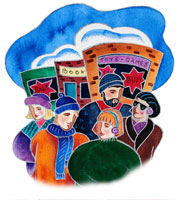When Wal-Mart starts its holiday markdowns three weeks before Thanksgiving, you know it will be a tough Christmas season.
The Arkansas-based discount chain, a bellwether for U.S. retailing, usually holds off on its “door buster” sales until the day after Thanksgiving, traditionally the year’s busiest shopping day. This year, Wal-Mart decided that it couldn’t afford to wait.
No wonder, say scholars at the Wharton School and retail analysts. A host of economic worries has this year shaping up to be a lump-of-coal shopping season. Consumers are cash-strapped because of rising debts and high gas prices. On top of that, unseasonably warm weather in October kept them out of stores, so firms are already struggling with too much inventory. And a spate of toy recalls has brought bad publicity for the retail business at the worst possible time.
“Our forecasts are expecting growth in retail sales to be the worst in the last four or five years, although we’re not talking recession-like numbers,” says Scott Hoyt, director of consumer economics at Moody’s economy.com. “The whole state of consumer fundamentals is worse than it’s been in several years. Debt burdens are high. Growth in wealth has slowed largely due to woes in the housing market. And energy prices are high and rising. Most of the projections for winter heating costs have them soaring.”
Retail marketers, for their part, will do what they can to counter the problems and lure consumers into plunking down their cash and credit cards, but ultimately their most powerful tool is the one that Wal-Mart has already resorted to: price cutting. That will mean lower profits even if traffic picks up.
“Supply chains and lead times are so short now that when you order something, you get it,” says Erin Armendinger, managing director of Wharton’s Jay H. Baker Retailing Initiative. “It’s difficult to cancel the orders. So you really have nothing left to do but start marking down.” Apparel sellers, in particular, are seeing unsold goods clog up their inventory pipelines, she notes. “We have had this wacky warm weather so people didn’t buy sweaters and coats. The back-to-school season was a bust.”
The unsold fall merchandise has created a logjam, preventing retailers from bringing Christmas goods into their stores, adds Wharton marketing professor Stephen Hoch. One season’s bad news has begun to bleed into the next. “Retailers won’t have the right mix of merchandise in the store, and they can’t pull the older goods [off the shelves] because reverse logistics costs a ton of money.”
The existence of too many stores could make a bleak outlook even bleaker, according to Hoch. Thanks to five years of strong consumer spending, some retailers may have grown too large. A number of department-store chains already have begun shuttering outlets. If troubles in the housing market persist, hardware sellers may follow the same strategy. “Home Depot and Lowe’s are very tied to the housing sector,” Hoch notes. “They rode that tide, and now there are close to 4,000 very large home-improvement centers in America. At some point, you start stealing sales from yourself.”
Earlier this week, Home Depot reported a 26.8% drop in third quarter profit, while Wal-Mart showed an 8% increase for the same period.
Paying a Safety Premium
While certainly not helping retailers, the raft of toy recalls probably won’t greatly exacerbate the overall retail sector’s woes, Hoch predicts. Since this summer, Mattel has issued several recalls of toys, including Ernie, Elmo, Dora the Explorer and Big Bird, plus accessories for its famed Barbie dolls. Some of the toys were covered with toxic lead-based paint. Others included small, powerful magnets that could perforate children’s intestines if swallowed. Also this summer, RC2, maker of Thomas the Tank Engine toy trains, recalled some products due to the presence of lead paint. And in early November, Australia-based Moose Enterprise recalled its Aqua Dots –little beads that stick together when wet — because a factory in a southeastern Chinese city had used a toxic chemical in place of a nontoxic one when making them. Several children became sick after swallowing the beads. Most of the recalled toys were manufactured in China, although a few were made in Mexico.
Scary headlines like these may lead a few parents, especially affluent ones, to turn away from toys and purchase alternatives, such as electronic devices, Hoch says. But many more of them will still tramp to Wal-Mart, Target and Toys R Us and scoop up the same sorts of Chinese-made merchandise that they have always bought. “It’s not clear to me that there’s an obvious substitute. If it weren’t for ‘Made in China,’ there would be no toys in the stores — or clothes, either. We would all be running around naked.”
Even if total toy sales aren’t hurt by the recalls, Mattel could feel aftershocks because its toys have accounted for many of the recalls. “People might associate Mattel and China, and that could have a marginal impact,” Hoch adds.
Wharton marketing professor John Zhang agrees that toy buyers have few alternatives to Chinese-made wares. But he predicts that, even if overall toy sales don’t slip, the composition of those sales might change. “I think you will see people trading up,” he says. Some parents might try to purchase toys made in places besides China. Others will look for Chinese-made toys that have been certified as safe in some way, and retailers will probably charge more for those offerings. “There is a distinct possibility that consumers may have to pay a safety premium this year,” he suggests.
To take advantage of the opportunity to charge more, some toy retailers may look to promote non-Chinese-made goods on their shelves. Others may highlight the steps that they have taken to ensure the safety of their offerings. “All of these products were ordered early in the year, and it’s not like you can make a shift now,” Zhang notes. “So if you’re a retailer, you’ll probably want to play off the fact that you’re doing a lot of inspections.”
China, too, is already trying to reassure buyers around the world about its products, according to Zhang. The central government increased inspections and cracked down on shoddy manufacturers. It has also pointed out that its factories are not the only ones making mistakes; it announced a list of faulty U.S.-made products that had been sent to China. And in Guangdong province, home of most of China’s toy makers, the provincial government has announced that it plans to help some manufacturers sue Mattel. The manufacturers “are saying their reputation is being damaged for design and inspection mistakes by Mattel,” Zhang says.
The ‘Goliath Effect’
Patti Williams, a Wharton marketing professor, also suggests that some retailers might try to highlight the safety of the offerings, but cautioned that this strategy could backfire. “I’m not sure you want to keep consumers in the mindset of being concerned about toys,” she says. Doing that could re-enforce people’s fears rather than allaying them. Instead of seeking safer toys, they might turn away from the category entirely.
Rather than underscoring safety, toy marketers should point to other benefits that their products provide, she suggests. That not only draws attention away from the recalls, but also “gives you a better position later when safety becomes less of an issue.”
Wharton marketing professor Jonah Berger adds that Mattel, in particular, could find itself tightrope-walking between the need to reassure consumers and a desire not to continue the national conversation about dangerous toys. Like Williams, he points out that, as a rule, companies should shy away from talking too much about problems with their products because doing so risks cementing that association in people’s minds.
But that advice doesn’t necessarily apply to a dominant firm like Mattel, he notes. Large, well-known firms may need to do more to try to shape public perception because they can get blamed for problems even in situations where they are not at fault. “Rumors tend to stick to large companies. It’s called the ‘Goliath effect.’ So the larger companies need to do more to ensure that consumers understand that their products are safe.”
Unlike his colleagues, Joel Waldfogel, a Wharton business and public policy professor, wasn’t worried about consumers spending too little this Christmas. He thinks they will spend too much. By his estimation, holiday gift purchases waste a ton of money.
In a string of research that stretches over more than a decade, Waldfogel has observed that many people buy gifts that cost far more than the value that the recipients assign to them. For example, a father buys his son a set of golf clubs because of how much he loves the game and because he knows his son would, too, if he just gave it a try. Waldfogel calls the difference between what the father paid for the clubs and the value the son gives to them “the deadweight loss of Christmas.” Multiply that difference by the millions of gifts exchanged each year, and Santa starts to look like the worst kind of spendthrift.
Retailers, for their part, even play off the fact that consumers fall into a gift-buying trap at holiday time: Shoppers are often pressed for time when they shop, but feel that they have to buy something. “Around the holidays, you will see these tables covered with things literally meant as gifts — useless items that you can quickly purchase,” Waldfogel says. “My wife now calls them the ‘deadweight kiosks.’ A lot of it is golf themed, and who really needs a golf beer mug?”
Under Waldfogel’s formulation, the perfect gift is cash, since the giver and the receiver value it in exactly the same way. But many people regard cash gifts as lazy and even inconsiderate. They are offended by the idea that the giver didn’t make any effort to shop for them.
Waldfogel acknowledges that this social norm exercises a powerful sway over people’s interactions. And despite jokes about deadweight losses, he still buys gifts for the people he is closest to. But he says that his research has changed the way that he shops. “I try to be a thoughtful gift giver and keep my eye open for something that the person would really like,” he says. “The problem happens when you try to go out on one day and find gifts for 10 people. What are the chances that you are going to find something good for each of them?”



